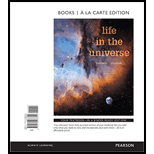
What is a habitable zone, and how is the idea useful? Is a planet in the habitable zone necessarily habitable? Explain.
The definition of the habitable zone with its usefulness and discuss the habitability of the planets belonging to the same habitable zone.
Answer to Problem 1RQ
Habitable zones are the area around the central star which has an possiblity of supporting life. Every planet present in an habitable zone does not neseccarily support life as there are various other factors which are required for life to exist on a planet.
Explanation of Solution
Habitable zone is an area around a particular star i.e. the orbital region which has an ability to support different forms of life. The sustenance of life on a particular planet is determined by presence of the various life supporting matters such as water, oxygen, carbon dioxide etc. The planets belonging to the same habitable zone has a higher possibility of life sustenance as the conditions they are exposed to is similar.
All the planets present in a habitable zone does not necessarily support life because there are various other factors which is helpful to determine the habitability of the planet. Factors which are necessary to support life on a planet is as given below.
Luminosity- It is defined as the brightness of the planet in other words the temperature on the planet.
If the solar system in which the sun is the central star is considered, the luminosity of the planets can be determined by the distance of the planets from the sun.
To maintain an optimum temperature the planet need to be in a region which is neither too close to the sun nor too far. Closeness to the sun makes the planet hotter and the distant planets are at very lower temperature. Thus luminosity which can be determined by the distance from the sun plays an important role in sustenance of life.
Size of planet- Except the distance of the planet from the central star, its size plays an important role to sustain life. The planet needs to be large enough to retain heat and to bear plate tectonics to regulate the climate.
Atmospheric conditions- The atmosphere on the planet should be sufficient to retain the liquid water on the surface. Also its presence prevents the exposure of the life to various harmful radiations which play a vital role of existence of life on the planet.
Conclusion:
Thus, habitable zones are the area around the central star which has a possibility of supporting life. Every planet present in an habitable zone does not necessarily support life as there are various other factors which are required for life to exist on a planet.
Want to see more full solutions like this?
Chapter 10 Solutions
Life in the Universe, Books a la Carte Plus Mastering Astronomy with Pearson eText -- Access Card Package (4th Edition)
Additional Science Textbook Solutions
An Introduction to Thermal Physics
College Physics
Applied Physics (11th Edition)
College Physics
Essential University Physics (3rd Edition)
Physics for Scientists and Engineers with Modern Physics
- In this chapter, we identify these characteristic properties of life: life extracts energy from its environment, and has a means of encoding and replicating information in order to make faithful copies of itself. Does this definition fully capture what we think of as “life”? How might our definition be biased by our terrestrial environment?arrow_forwardWhat are the three requirements that scientists believe an environment needs to supply life with in order to be considered habitable?arrow_forwardHow can a planet’s atmosphere affect the width of the habitable zone in its planetary system?arrow_forward
- If we do find life on Mars, what might be some ways to check whether it formed separately from Earth life, or whether exchanges of material between the two planets meant that the two forms of life have a common origin?arrow_forwardIf you represent Earths history by a line that is 1 m long, how long a segment would represent the 400 million years since life first moved onto the land? How long a segment would represent the 4-millionyear history of humanoid life?arrow_forwardIf you represent Earth’s history by a line 1 m long, how long a segment would represent the 400 million years since life moved onto the land? How long a segment would represent the 4-million-year history of human life?arrow_forward
- A radio broadcast left Earth in 1911. How far in light years has it traveled? If there is, on average, 1 star system per 400 cubic light years, how many star systems has this broadcast reached? Assume that the fraction of these star systems that have planets is 0.50 and that, in a given planetary system, the average number of planets that have orbited in the habitable zone for 4 billion years is 0.20. How many possible planets with life could have heard this signal?arrow_forwardwhy do scientists generally think that liquid water is necessary for the origin of life? (astronomy)arrow_forwardIf you detected radio signals with an average wavelength of 20.000 cm and suspected that they came from a civilization on a distant Earth-like exoplanet, roughly how much of a change in wavelength should you expect to detect as a result of the orbital motion of the distant exoplanet? (Hint: Use the Doppler shift formula, Eq. 7-3.) (Note: Earths orbital velocity is 30 km/s.)arrow_forward
 AstronomyPhysicsISBN:9781938168284Author:Andrew Fraknoi; David Morrison; Sidney C. WolffPublisher:OpenStax
AstronomyPhysicsISBN:9781938168284Author:Andrew Fraknoi; David Morrison; Sidney C. WolffPublisher:OpenStax
 Horizons: Exploring the Universe (MindTap Course ...PhysicsISBN:9781305960961Author:Michael A. Seeds, Dana BackmanPublisher:Cengage Learning
Horizons: Exploring the Universe (MindTap Course ...PhysicsISBN:9781305960961Author:Michael A. Seeds, Dana BackmanPublisher:Cengage Learning Stars and Galaxies (MindTap Course List)PhysicsISBN:9781337399944Author:Michael A. SeedsPublisher:Cengage Learning
Stars and Galaxies (MindTap Course List)PhysicsISBN:9781337399944Author:Michael A. SeedsPublisher:Cengage Learning Foundations of Astronomy (MindTap Course List)PhysicsISBN:9781337399920Author:Michael A. Seeds, Dana BackmanPublisher:Cengage Learning
Foundations of Astronomy (MindTap Course List)PhysicsISBN:9781337399920Author:Michael A. Seeds, Dana BackmanPublisher:Cengage Learning




